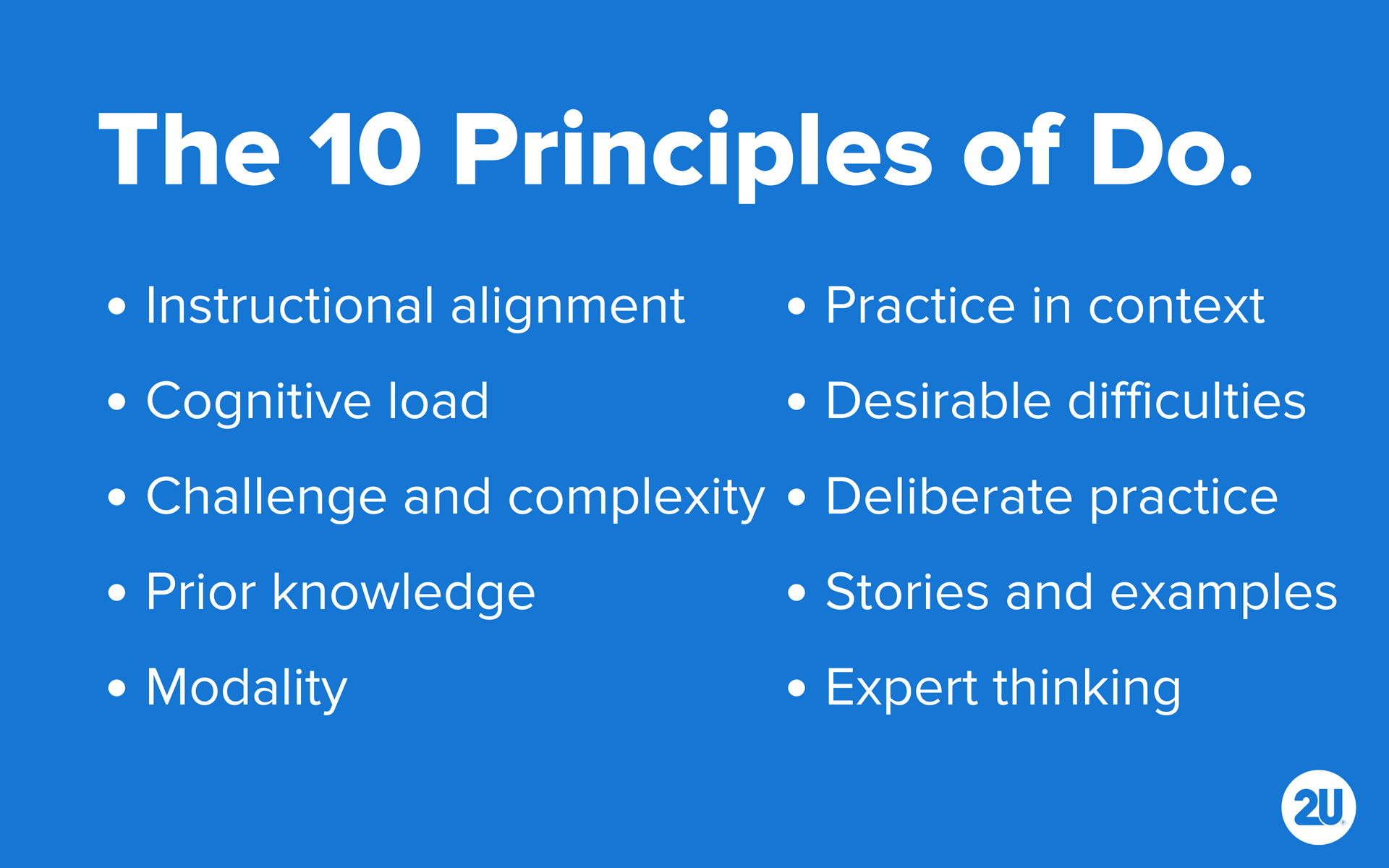Mission
Practice Makes Perfect: The Art of Doing in Learning
Written by Rachel Koblic on Oct 15, 2020
Related content: Learning Design, Digital Education

How did you study in school? Did you skim pages and highlight important passages? Did you re-read textbook chapters in hopes of memorizing the main concepts? Did you sit through lectures and furiously scribble pages of illegible notes to be deciphered late at night with the help of a gallon of coffee? If you said yes to all of the above, you’re not alone. I, too, tried a lot of these tactics to succeed in my learning.
How did those tactics work out for you? Personally, I don’t remember too many specifics from most of my college classes, nor am I confident that I could apply the skills today that I was supposed to have learned at school. For me, the moments in my life in which I feel like I’ve learned the deepest and remembered the longest are those in which I’ve had to get involved, struggle through a problem, and take action to find a solution.
For example, when COVID-19 forced us all into isolation earlier this year, I wanted a safe way to enjoy the great outdoors. Growing tomatoes in my backyard felt like a natural option, especially given my love for cooking. While I had seen tomatoes, cooked with tomatoes, and eaten tomatoes, I had never grown them before—I had to learn. To do so, I didn’t just watch a YouTube video, read an online article, and take a test on how to grow tomatoes—I purchased real, live tomato plants, and I grew them. I learned how to prune them by pruning them. I learned how to treat pests because my plants got aphids and I had to figure out how to save my crops. Along the way, I made mistakes like spraying the plant leaves with neem oil and leaving them out in the sun to burn, but I learned from those mistakes and have successfully grown tomatoes that are surprisingly delicious for having been grown in a Brooklyn backyard—all by doing.
When it comes to effective learning, active learning is key. Students learn best by doing, or put more eloquently, through applied practice. It’s critical to making sure that learning is usable and not inert. At 2U, we help our partners embed active, applied practice in their learning experiences, and design effective and engaging content to support it.
The Do of Learning
2U’s Learning Design & Development (LD&D) teams are responsible for not only playing close attention to what the learner is doing but also how the learner is doing it. We focus on fostering long-lasting and transferable learning, which we accomplish by helping our partners follow the 10 principles of Do, one of the three learner-focused dimensions (Feel, Do, and Think) that shape our Learning Experience Framework (LXF).

The Do dimension applies to the very tangible bulk of the learning experience, so it includes comparatively more principles than Feel or Think. Together, the 10 principles help us choose the right material to cover—in the right ways—to make sure we’re meeting intended learning goals for the course. They help us deliver learning in a way that is manageable and not overwhelming for the student, but sufficiently challenging. The principles push us to think carefully about the context and rhythms of learning, and how to best produce it using the tools and technology at hand. They also help us with constructing powerful messages that enable the brain to latch on to new information and surface important invisible thoughts.
Do is multi-faceted and rich. It must be partnered with the feedback loop of Think, the third dimension of the LXF. And when we get it right, it reinforces the positive feelings of Feel, the first dimension of the LXF.
Do Done Right
Throughout our more than 12 years of experience, we’ve been fortunate to partner with universities that understand and value the importance of integrating the learning principles of Do when designing curriculum. But there’s one course in particular that comes to mind when I think of active learning done right: Negotiation—a course in the Washington University School of Law’s Master of Laws (LL.M.) program—currently led by Tomea Mayer Mersmann and designed in consultation with 2U’s LD&D experts. Negotiation masterfully employs a number of the Do principles, including practice in context, deliberate practice, and expert thinking.
Principle Example #1: Practice in Context. Both words are important here: practice and context. Practice means we have to actually do something to learn it, not just watch a lecture about how to do it. Context means that the practice should not happen in a vacuum—it should be situated within a real or realistic scenario. Knowledge and skills are generally not things that exist or are used independently of their surroundings. What I mean by that is that you very rarely do math, for example, for the purpose of adding two numbers alone (sorry, mathematicians). We’re usually doing math for a particular reason in a particular scenario—like calculating how much money you have to buy gardening supplies. Learning is most effective when it too occurs in scenarios. It makes knowledge and skills easier to use in the real world.
Professor Mersmann’s Negotiation course centers around practice in context. To learn how to negotiate, one must actually negotiate! So, every two weeks, students participate in a negotiation role play in live, online sessions with their peers. In the two weeks leading up, they are prepared with lectures and readings on core concepts explaining “how to” do the skills. They review prep materials that bring to life the realistic scenario of the negotiation—negotiating a wedding hall rental, for example—and come to live sessions ready to negotiate and debrief. The cycle repeats every two weeks.
Principle Example #2: Deliberate Practice. Repeating the cycle is not enough. When we hear “practice” we often think about drill and repeat—doing something repetitively over and over again. Unfortunately, the act of repetition alone isn’t going to help you learn most effectively. A few years back I tried to learn how to swim. I didn’t use a coach. I just got in the water and tried to remember what I had learned when I was a kid, swimming laps several times per week. The result? A shoulder injury. Deliberate practice refers to breaking a task down into its component steps, creating an intentional and targeted training plan, working through each step in a mindful way, and incorporating feedback (ideally from an expert) into successive attempts.
Negotiation is an excellent example of this principle in practice. The negotiation process is composed of component steps and skills, including analysis, interpersonal awareness, planning, drafting, and reflection. Professor Mersmann creates a deliberately tailored course of practice throughout the course, layering in each of these skills. Students receive personalized feedback on their negotiation skills in the live session, but also have the opportunity to watch asynchronous videos of near-peer students conducting the same negotiation and debriefing with an expert.
Principle Example #3: Expert Thinking. The main premise of expert thinking is that students learn best when they are exposed to the invisible thought processes of experts. Think about any skill—growing tomatoes, playing video games, driving a car. What you observe an expert doing is only the tip of the iceberg. Under the surface, the expert is taking in information, weighing it, anticipating outcomes, and making decisions. Students benefit from being exposed to this thinking as they are learning how to make decisions themselves.
The art of negotiation is exceptionally complex. Every situation is different and you often have to make decisions on the spot. Professor Mersmann’s Negotiation course does an exemplary job of surfacing the expert decision making process. Part of the magic of watching near-peers debrief with the expert, as mentioned above, is that students are exposed to the sophisticated thought process in a narrated, post-game breakdown of how the expert would have interpreted and responded to the cues of the negotiation.
Why We Do What We Do
Research shows that people learn best by doing. But the doing has to be structured in a way that not only informs what students should learn but also how they should learn it for the best outcomes. Whether it be incorporating skills practice in a realistic and relatable scenario, creating mindful learning opportunities that incorporate feedback, or providing students with exposure to the thought processes of experts, we’re constantly exploring new, impactful, and engaging ways to design and develop experiences that center around active learning strategies and ultimately improve the student experience.
To learn more about the LXF, read Rachel’s article introducing the framework and her deep dive into the LXF’s first learner-focused dimension, Feel.
Latest.
Learn more about us.
At 2U, we’re on a mission—to eliminate the back row in higher education and help universities thrive in the digital age. To learn more about who we are and what we do, follow the links below.